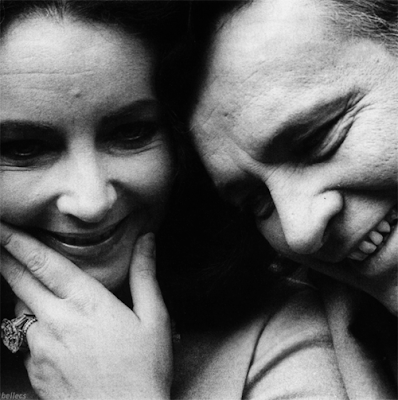The photograph was of Elizabeth Taylor and Richard Burton. It's a black and white double portrait taken by Albert Watson some time in the mid 1960s. I still have it, to this very day, and whenever I moved house (which, being a serial house mover, was often) the - long since beautifully framed - photograph was taken along.
I can't say if the original photograph was taken during a sitting or if it's a snapshot, though my guess is, that it's probably the result of a sitting. I've been obsessed with Taylor and Burton by varying degrees ever since I was a little boy when I read about them in the many tabloids my mother used to be a subscriber to. As I grew older and my sources of information on Taylor and Burton became more reliable, my erstwhile obsession turned into fascination and eventually admiration. I realised that behind the undoubtedly glamorous façade of their affair there was a couple deeply devoted to each other, both hailing from backgrounds that couldn't possibly be any more different, both extremely talented each in their own way, and both of a superior intelligence which, in Richard, manifested itself in a supreme, often self-deprecating wit, while in Elizabeth, it expressed itself in a rare, razor-sharp, sense of self and in an equally rare ability to laugh at herself.
Taylor was also full of contradictions who felt equally at home at London's Dorchester Hotel as she did in a Welsh pub, feasting on beer and rarebit. That's precisely part of what won over Burton's large family and endeared Elizabeth to them, even though they blamed her at first for breaking up Burton's marriage to Sybil. Taylor, for all her extravagance and her notorious love for diamonds and jewels, probably was one of the most unpretentious and simple movie stars imaginable. Perhaps, it's because she was born into wealth that, although used to it, didn't mind not having it - on occasion. In any case, though her display of wealth would occasionally be ostentatious, she was never pretentious, or worse, arrogant.
Moreover, in the 1950s and 60s, Elizabeth was a worldwide trailblazer in making homosexuality socially acceptable. Much later, and more admirably still, she would be the first A-list celebrity to publicly stand up for people with HIV and AIDS. Eventually, her efforts to raise funds to combat the deadly disease, would wash millions into the coffers of many an organisation, not least of which her own, the Elizabeth Taylor AIDS Foundation.
But back to the photograph.
Needless to say, there are thousands of photographs of Taylor and Burton, her probably being the most photographed woman of the 20th century bar none. However, what intrigued me about this particular one is the expression on the faces of both, Taylor and Burton. It's perhaps the only photograph of a (married) couple I can think of that manages to perfection to capture their love for each other, making this love very obviously and believably visible, if not palpable.
Taylor's face seems to say, "See, that's us, we're an item and always will be, and nothing and nobody will ever come between us", while his expression is one of complete devotion - perhaps even submission - to her. I have no idea, of course, how long it took Watson to take the photograph, let alone if its end result is what he was after in the first place. All I know is that it's an outstandingly beautiful photograph - in all its simplicity - and that no matter how deep the feelings are between two people, I suppose that it still takes a highly skilled photographer to get these feelings across in one single image.
Howsoever.
This, often referred to as Marriage of the Century, has become the subject of a book by Sam Kashner and Nancy Schoenberger, aptly titled Furious Love. Of course, you may argue that with theirs having been such a highly publicised affair - their excesses having been covered by the international press to a heretofore unprecedented degree - what can there possibly be that we don't know already?
Well, for one thing, this, shall we say, Anatomy of a Marriage, was undertaken with the approval of none other than Dame Elizabeth Taylor herself. She even gave the authors unprecedented access to love letters by Richard Burton to her and the excerpts of these alone make the book worth reading. For it is one thing to know that theirs was indeed a furious love, but it's another to be presented with first-hand evidence, making you realise, for instance, that besides being a great actor, there also was a gifted poet hiding inside Burton.
Furious Love is a monument - a celebration - to two of the most fascinating and talented, figures in film history, accurately retracing their affair, marriage, and collaborations, down to their excessive, fascinating, sometimes lurid, detail.
Indeed, reading the book made me hanker for a different world, the world of yesteryear, a world beyond the false morality and political correctness of today where, instead of attending yoga class followed by a macro-biotic meal, only to be in bed by ten, two newly weds - after an excessive shopping spree on Via dei Condotti - would booze on champagne until dawn before passionately making love, looking much the worse for wear on the set the next day but couldn't care less ...
Furious Love was published by Harper Collins in 2010. It is available on Amazon.





